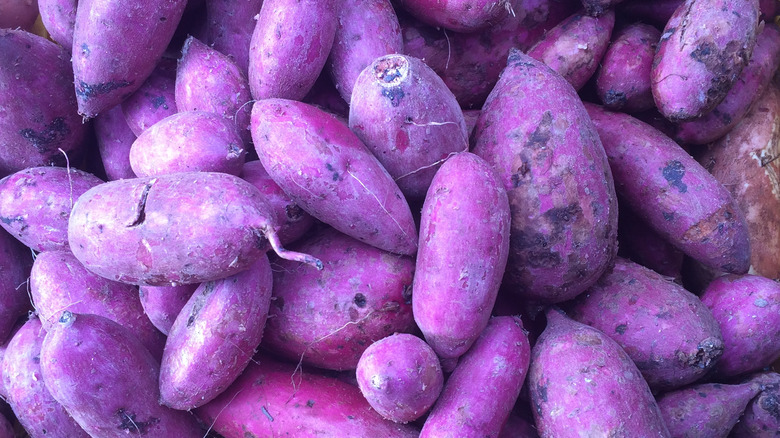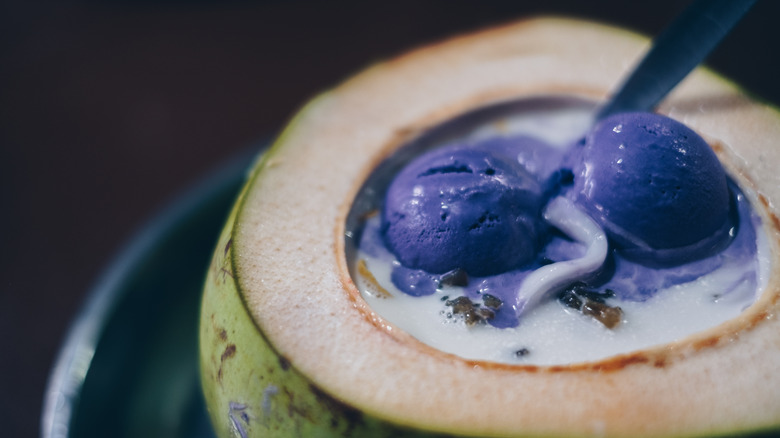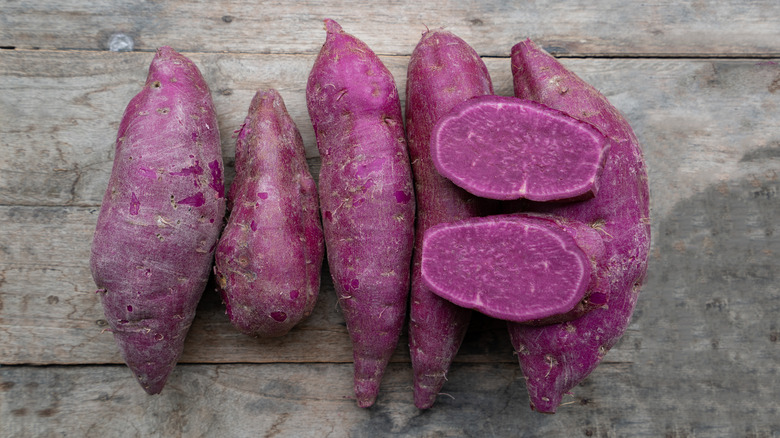The Flavor Of Ube Is More Than Your Average Purple Sweet Potato
Ube — that unique, sweet, deeply purple tuber that you might notice popping up in things like baked goods and ice cream — is often thought of as just another word for a purple sweet potato. But while the two do share many similarities, these are actually two completely different vegetables.
Which means that they taste different, too. Both root vegetables have a natural earthiness to them; however, where purple sweet potatoes are mildly sweet and sometimes even floral, ube tends to be richer in flavor — not just sweet, but also nutty with almost a vanilla flavor to them.
Ube also comes with a pleasing aroma that's often described as similar to vanilla or coconut. Since our sense of smell contributes to a large percentage of our perceived taste, this subtly sweet scent contributes to the unique notes of flavor found in each bite of ube, which separates them from your average purple sweet potato — which is a little more floral and starchy.
Foods that highlight the flavors of ube
Ube is one of the Philippines' most plentiful crops. So while it's becoming a more popular ingredient here in the U.S., it's native to Southeast Asia and most often found in both traditional and modern Filipino cuisine.
You'll especially find this colorful yam as the star of many Filipino sweets, and it makes sense why: Its rich, nutty, and vanilla-like flavor works well in baked goods and desserts, but since it's an earthy vegetable, it's not overly sweet and ultimately helps to balance out desserts. The flavors of ube pair well with foods like coconut and coconut milk, fruit, and even more savory ingredients like cheese and rice.
Halo-halo is a popular Filipino shaved ice dessert that features ube alongside an array of other ingredients and toppings like sweetened beans and fruit, sago pearls, ice cream, and evaporated milk. Ube halaya is a jam made with ube, condensed milk, and coconut milk. Ube is also used to flavor ice cream, cookies, rice cakes, fluffy pastries, and cheesy breads.
More differences between ube and purple sweet potatoes
Flavor isn't the only subtle distinction between ube (technically purple yams) and purple sweet potatoes. Although the two are notoriously easy to confuse, their appearance, texture, and nutritional makeup are all slightly different as well.
Since they come from different plant families, yams and sweet potatoes are different. Ube has a thicker, tougher skin that's bark-like and is largely considered inedible — while purple sweet potatoes have a thin, smooth skin that's easier to eat. The flesh of ube can be white or light lavender to deep purple in color, and its texture is more moist; purple sweet potatoes have a more consistent purple-colored flesh that tends to be dry and starchy.
Nutritionally speaking, both vegetables contain powerful antioxidants that give them their purple color. But ube has higher amounts of Vitamin A, Vitamin C, and potassium, and purple sweet potatoes have a lower glycemic index. In a pinch, they can be swapped for each other when cooking, but the texture will be slightly off — and ube has that delicious pronounced vanilla, coconut flavor while purple sweet potatoes taste more floral.



